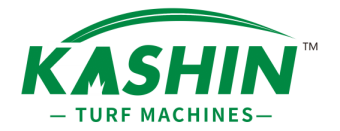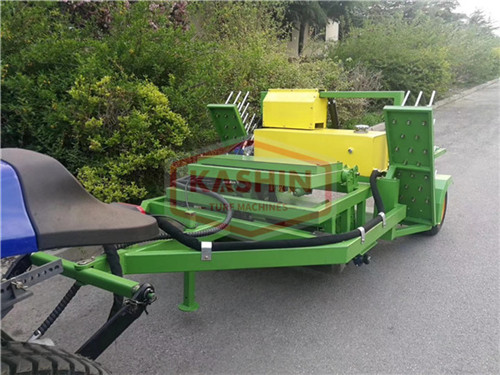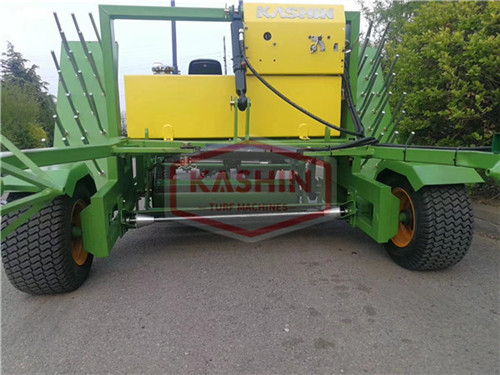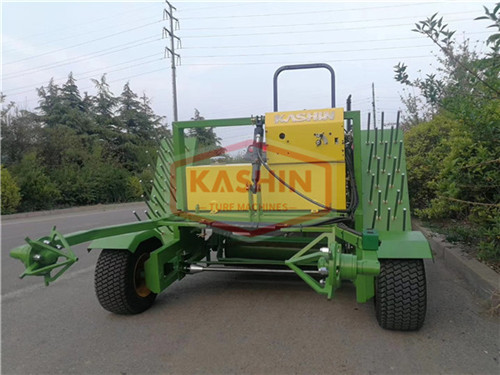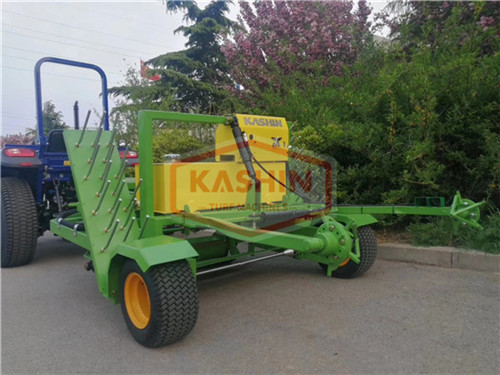Roll Sod Harvester
Author:Ricdro
The Sod Harvester proves our commitment to your business performance. This single-operator Sod Harvester is simple and state of the art. It is capable of producing pallet after pallet of 16”, 23” or 24” small rolls even in tender conditions. A simple robotic stacking system gently transfers 4 or 5 rolls of turf at a time to rear mounted pallets that are easily handled with a forklift. Easy to operate and maintain, the Sod Harvester is a cut above.
Features
Telematics allows for remote diagnostics, updates, adjustments and monitoring utilizing GSM/GPS communication
Compact, Maneuverable Automatic Stacking Roll Harvester with a tight turning radius and easy back up capability
Advanced Cutter Head with 2 roller adjustable down pressure
Robotic Stacking System can gently transfer 4 or 5 rolls of weak turf to pallets with our exclusive Gripper Head
OEM Deluxe Cab includes tinted windows, interior climate control and training seat
16” / 23” / 24” Cutting Widths
Automatic Pallet Injector can accommodate double sided pallets and holds approximately 18 pallets
Electronic Auto-Steer with micro adjustment
All Wheel Drive with Traction Control
127 HP Diesel Caterpillar Engine
Scrap roll eject system (on the go)
Squeeze function on upper layers
Adjustable stacking pressure
Pallets may be dropped on the go or easily backed out of the way of the cut line
Fully automated Auto Drive control for maintaining harvest ground speed
Electronically adjustable cut-off length
Proven automatic flap control
LED lighting
Finger tip controls for simple field adjustments
Fits in container for shipping
Excellent visibility of cutter, conveyor and piling area
Operation and diagnostic screen
Back-up camera
Multiple stacking patterns including flat and pyramid tops
Automatic moving piling walls produces a tighter pallet
Excellent machine stability and floatation on soft ground
Chassis tie downs for easy transport
Moreover, Automated Turf Harvester are provided with remote monitoring and diagnostics features, cellular or wireless communication systems, bilingual interface, and other features. Furthermore, the customers, majorly sod farmers, are switching toward automated equipment to increase the overall quality of the harvested turf. Thus, the Automated Turf Harvester industry has witnessed an unprecedented growth in recent years, owing to the high-quality harvesting process. In addition, the labor costs are mainly reduced by the implementation of Automated Turf Harvester on sod farms.
The Automated Turf Harvester market growth is driven by the shift of consumer preferences toward automated agricultural equipment. The Automated Turf Harvester enable better product quality than non-automated versions and also save time and labor required for the harvesting process. Furthermore, according to the data published by Sports Turf Managers Association, nearly 84% injuries were caused by playing on artificial turf and 92% players established that artificial turf was the reason for shortening of sports’ career. Thus, various sports federations are opting for natural turf on sports fields, which fuels the demand for turf cultivation and thereby, propels the Automated Turf Harvester market.
Moreover, labor shortages and high costs associated with labor intensive farming drives the demand for Automated Turf Harvester in the market. On the contrary, residential turf users are switching toward artificial turf for applications in lawns, which reduces the demand for natural turf and thereby, restrains the Automated Turf Harvester market. Also, the high costs of the Automated Turf Harvester is a major restraint for the market growth. The small and medium sized farm owners do not generate enough revenue to compensate the amount invested in the automated turf harvesting machines.
Roll harvester is a self-propelled, automatic stacking, roll harvester that showcases reliability in an innovative new design.
This compact, lightweight turf harvester is powered by a 99 HP engine. With all-wheel drive and rear wheel anti-spin control, the turf harvester stays on track in wet, muddy conditions. The 170 degree front steering axle with zero turning radius makes it ideal for smaller fields and quicker turns. The turf harvester is the most maneuverable turf harvester we have ever built. The deluxe cab with anti-vibration mounts has heat and air conditioning for a quiet, comfortable ride while providing the driver excellent visibility of the cutting head, conveyor and stacking functions. Its automatic flap control roll-up system places the flaps in perfect position for a neat, stable stack every time. Its rear-mounted automatic pallet injector holds 10 empty pallets. For international shipments, it folds down to fit into an ocean container, saving thousands of dollars in shipping. The turf harvester one-man turf harvester has the newest and latest technology with features requested by today’s turf producers. The turf harvester is the key to labor reduction, improved harvesting efficiency and higher profits.
Automation Turns the Hardest Job into the Easiest
Turf Harvester Equipment is a self-propelled, automated harvesting machine designed to help ease labor time and costs. harvesting and stacking turf—traditionally done by hand—is a labor intensive job which can make it difficult for farms to find employees. Automating this process, however, enables harvesting to go from a three-person operation to a one-person job.
The automates all aspects of the turf harvesting process. As the machine moves through a field via a self-propelled tractor, its cutter lifts turf from the ground and cuts it into slabs which are placed onto a conveyor that moves the slabs to the rear of the harvester. The machine’s stacker then moves the cut slabs from the conveyor to a pallet; while turf slabs are stacked onto the pallet, a set of pallet forks lowers the pallet closer to the ground until it is stacked with the desired number of turf slabs and placed on the ground.
For uninterrupted harvesting, a pallet magazine on the harvester stores empty pallets and inserts them onto the pallet forklift once a full pallet has been placed on the ground. This helps increase productivity for farmers by saving them as much as 35 seconds per pallet compared to machines that have to be stopped during the harvesting process to change pallets. Numerous sensors and digital outputs working in tandem on the machine enable a continuous, synchronized flow of communication between systems to ensure the harvester is able to work continuously, and accurately.
Improving the turf harvesting experience
The company’s engineering group has many years of experience in automation, mechanical design and motion control systems in various industries which it used in conjunction with its knowledge of the turf industry to develop the . This knowledge led the company to develop a harvester which says is the first of its kind to implement high performance electric servo motion control and fluid power systems.
Servo motors are used to control movement of the harvester’s —the system used for stacking cut slabs of turf onto pallets. This allows for smoother coordinated motion for more precise placement of turf slabs onto a pallet. The stacker has four axes of motion so the turf slabs can be placed on the pallets at different orientations. “This results in a much more stable pallet for transport,” says .
“The electric power delivery system used for our servo motion controls was developed in-house,” he adds.
Patented algorithms built into the guarantee perfectly square pallets of stacked turf slabs are produced in a fast and efficient manner. They also allow speed of the stacker to be adjusted based on how tender or stiff the turf being harvested is to ensure quality is maintained.
Electronic auto-steering on the turf harvester enables operators to cut straight lines as they move through a field. It uses a simple mechanical guide rod to follow the ridge of the previous cut of turf. The guide rod is connected to an encoder that provides feedback to the steering control system. says steering is controlled by a controller from which outputs signals to an electrohydraulic steering control valve to move the steering wheels.
The controller is designed to provide high-performance control and monitoring in harsh operating environments. It includes a processor and reconfigurable field-programmable gate array technology; has become more prevalent in equipment designs to meet increasing requirements for speed, reliability and security. “Much of [the harvester’s] high performance can be attributed to the fast motion control system that is controlled by the .”
Low ground pressure was also an important aspect of the design process; according to it was one of the driving design requirements in the early stages of the machine’s development. “This requirement drove the decision to build a self-propelled machine, instead of a machine built off any existing platform,” he explains. “The basic geometry of the machine is dictated by the needs of the turf harvesting operation.”
By placing the lawn harvester’s engine on the opposite side of the conveyor and cutter, the company was able to ensure weight balance without the need for an extra ballast. Placement of the high flotation radial tires also helps achieve optimal weight balance, as well as flotation to reduce soil compaction.
Operator comfort was also taken into consideration when designing the . The cab provides a clear view of the cutter head, conveyor and stacker so operators do not have to twist or strain their bodies to monitor their work. Visibility is further enhanced by the air-ride seat’s ability to swivel over 180 degrees. “Our cab is comfortable and climate controlled. It helps turf farmers hire and retain better quality labor,” says .
optimized the operator experience by integrating the latest computing technology into the harvester. Its Intelligent Digital Control system features an interface with a simplified design and intuitive controls to make machine operation as easy as possible.
Fast and efficient design
The offers up to a 20% increase in harvesting speeds and 50% reduction in fuel consumption. says this was achieved by using good fundamental design practices through sizing of the electric power generation and fluid power systems. All components were sized to run in the fuel efficiency “sweet spot” of the harvester’s .
In addition, he says “the electric servo motors that run our stacker gantry are much more efficient than hydraulic motion control systems that have been used on other machines.”
He notes that the use of ’hardware and software were also large factors in enabling the company’s rapid development of a machine with advanced controls. “This machine was designed and built in about 9 months with a team of four engineers,”
said in a case study it wrote on the use of ’technologies that the ’s modular I/O enabled flexibility in using a wide range of sensor types and connectivity. It also allowed customization and the implementation of complex, highly synchronized control systems. Meanwhile, the software provided an open and flexible platform capable of handling the design of many complex controller functions which needed to be built into the machine.
